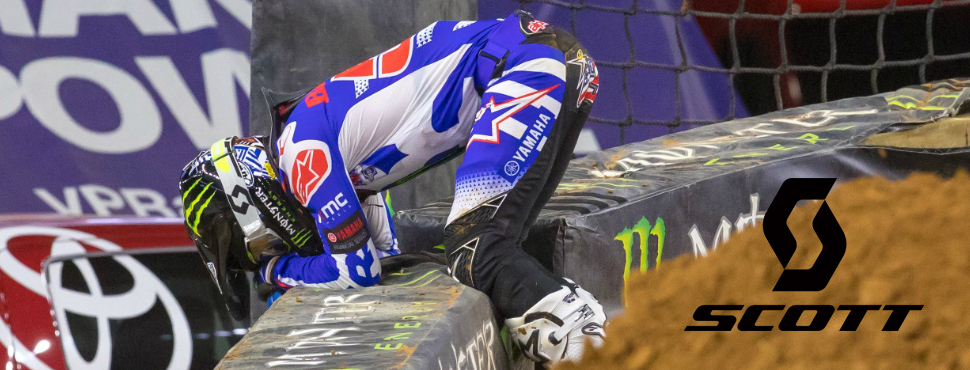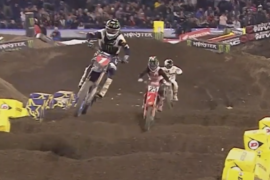Photos by: Chase Yocom
“Cooksey’s Hard Truth” presented by Scott Sports is a weekly editorial written by Chris Cooksey. Chris will be diving in and out of controversial subjects and bringing you his hard truth about the racing and the riders from around the world of Supercross and Motocross.
Motorcycles have always been the center of my life. I purchased my current home because of the open desert riding area directly behind me. I never cared to view the inside of the house; I was fascinated by the idea of riding straight from the garage. Before I married my wife, I thoroughly explained to her that motorcycles were the one thing I would not ever give up. I warned her that if she ever gave me the ultimatum “me or the motorcycles” she might not like the answer. Let’s be real, though, I would not get a divorce over a motorcycle, but my subsequent depression would probably have my wife divorcing me. Plus, I married up, so I pick my battles carefully. I bring attention to these details of my life because I love the sport of Supercross far more than an average fan. As a purist I hate any type of change, but sometimes changes are necessary for the survival and growth of the sport and outweigh our personal views.

Starting with the motorcycles in Supercross, can we all admit the AMA completely overshot the size of 4 stroke motors? While it is not fiscally realistic to rewrite this rule, motorcycles can be restricted. I am not aware of the exact method, but other forms of motorsports restrict power when speeds get out of control. As history shows us, this also makes racing more competitive along with making cars/motorcycles more reliable. Slower speeds almost always produce safer racing conditions. In 1990, Supercross was still dangerous, but the amount of catastrophic injuries was far less. The main difference between 1990 and today is the speed. I too am realistic about the dangers of racing motorcycles; I have had over 20 surgeries throughout my less than stellar career. Danger is part of the intrigue, but sometimes we need to be protected from ourselves.
For reference, take a trip down memory lame to the 1990 Anaheim SX
In no way am I suggesting the sport be turned into some form of powder puff racing. I am merely suggesting small changes to ensure this dangerous and exciting sport has room to grow. Unlike equipment used in stick and ball sports, motorcycles are improving by leaps and bounds. Unfortunately, safety equipment and track design have not evolved at the same rate. The berm restraint system [the nets on outside of bowl berms] is a step in the right direction, I am almost certain Blake Baggett would have been injured had the berm restraint system not been in place outside of the berm in Tampa. I would like to see some form of restraint between lanes to reduce the chances of head on collisions like the one experienced by Jon Ames and Chaz Braden in Dallas.
One more change I would like to see implemented is a tire tread rule. No matter the track design or preparation, the tracks break down almost instantly. If tire manufacturers were given knobby height limitations, the track would hold up far better. Tracks will always break down and that is part of the challenge, but a modern-day factory 450 can cut through the track like a hot knife through butter. A tire with less grip will also allow 250 riders larger in stature the ability to stay competitive. Less grip means more rider technique and nullifies excess power output. Seeing a 450 with a 5-foot run launch over a 100-foot quad would not exist. Decisions to clear the triple would need to be made 5 feet earlier, thus giving riders behind more warning. I am not saying this would eliminate incidents like Ben Lamay landing on Justin Bogle or Tyler Bowers landing on Justin Barcia, but studies need to be conducted to determine what gives the riders the best opportunities to avoid catastrophic incidents.
Finally, I do not understand why the AMA, Feld or the riders do not demand a safety commission, much like what Trey Canard proposed and implemented at Anaheim 1. I am not calling for these changes to allow the faint of heart into the sport. When you lineup 22 of the world’s best riders, drop a gate and send them barreling into the first turn, it’s impossible to fake courage, and adding a few safety features won’t change this. Diehard fans of Supercross tend to lose their mind when changes are implemented or even discussed. These same fans go to watch the stars of the sport show their skills. Keyboard warriors everywhere claim they watch and attend Supercross events despite the injuries and lack of a championship battle, but the numbers don’t lie; the keyboard warriors do. When the series loses stars and the points race becomes a runaway, interest declines. Supercross is a sport driven by personalities, danger, skill and money. All I am saying is let’s put more effort into matching the safety innovations with the bike and rider innovations.

This isn’t an argument to make the sport acceptable for everyone; it’s a long-term sustainability of the sport argument. Even with additional safety measures in place the sport of Supercross is extremely dangerous and only brave souls will compete. Riders have a way of overlooking the dangers and pushing forward, so much so that they pay little or no attention to safety issues. That’s the mentality of a racer and somebody should protect them.




